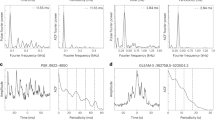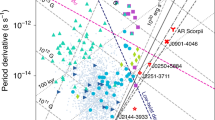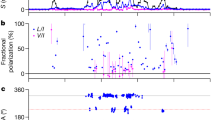Abstract
Radio pulsars are rotating neutron stars that emit beams of radiowaves from regions above their magnetic poles. Popular theories1,2,3,4 of the emission mechanism require continuous electron–positron pair production, with the potential responsible for accelerating the particles being inversely related to the spin period. Pair production will stop when the potential drops below a threshold, so the models predict that radio emission will cease when the period exceeds a value that depends on the magnetic field strength and configuration. Here we show that the pulsar J2144−3933, previously thought to have a period of 2.84 s, actually has a period of 8.51 s, which is by far the longest of any known radio pulsar. Moreover, under the usual model assumptions5, based on the neutron-star equations of state, this slowly rotating pulsar should not be emitting a radio beam. Therefore either the model assumptions are wrong, or current theories of radio emission must be revised.
This is a preview of subscription content, access via your institution
Access options
Subscribe to this journal
Receive 51 print issues and online access
$199.00 per year
only $3.90 per issue
Buy this article
- Purchase on Springer Link
- Instant access to full article PDF
Prices may be subject to local taxes which are calculated during checkout


Similar content being viewed by others
References
Ruderman, M. A. & Sutherland, P. G. Theory of pulsars: Polar gaps, sparks, and coherent microwave radiation. Astrophys. J. 196, 51–72 (1975).
Machabeli, G. Z. & Usov, V. V. Cyclotron instability in the magnetosphere of the Crab Nebula pulsar, and the origin of its radiation. Sov. Astron. Lett. 5, 238–241 (1979).
Cheng, A. F. & Ruderman, M. A. Particle acceleration and radio emission above pulsar polar caps. Astrophys. J. 235, 576–586 (1980).
Beskin, V. S., Gurevich, A. V. & Istomin, Y. N. Theory of the radio emission of pulsars. Astrophys. Space Sci. 146, 205–281 (1988).
Manchester, R. N. & Taylor, J. H. Pulsars (Freeman, San Francisco, 1977).
Manchester, R. N. et al. The Parkes Southern Pulsar Survey — I. Observing and data analysis systems and initial results. Mon. Not. R. Astron. Soc. 279, 1235–1250 (1996).
Lyne, A. G. et al. The Parkes Southern Pulsar Survey — II. Final results and population analysis. Mon. Not. R. Astron. Soc. 295, 743–755 (1998).
D'Amico, N. et al. The Parkes Southern Pulsar Survey — III. Timing of long-period pulsars. Mon. Not. R. Astron. Soc. 297, 28–40 (1998).
Johnston, S., Nicastro, L. & Koribalski, B. Scintillation parameters for 49 pulsars. Mon. Not. R. Astron. Soc. 297, 108–116 (1998).
Camilo, F. & Nice, D. J. Timing parameters of 29 pulsars. Astrophys. J. 445, 756–761 (1995).
Lyne, A. G. & Manchester, R. N. The shape of pulsar radio beams. Mon. Not. R. Astron. Soc. 234, 477–508 (1988).
Rankin, J. M. Toward an empirical theory of pulsar emission. IV. Geometry of the core emission region. Astrophys. J. 352, 247–257 (1990).
Rankin, J. M. Toward an empirical theory of pulsar emission. I. Morphological taxonomy. Astrophys. J. 274, 333–358 (1983).
Manchester, R. N., Han, J. L. & Qiao, G. J. Polarization observations of 66 southern pulsars. Mon. Not. R. Astron. Soc. 295, 280–298 (1998).
van Paradijs, J., Taam, R. E. & van den Heuvel, E. P. J. On the nature of the ‘anomalous’ 6-s X-ray pulsars. Astron. Astrophys. 299, L41–L44 (1995).
Kouveliotou, C. et al. An X-ray pulsar with a superstrong magnetic field in the soft γ-ray repeater SGR1806-20. Nature 393, 235–237 (1998).
Duncan, R. C. & Thompson, C. Formation of very strongly magnetized neutron stars: Implications for gamma-ray bursts. Astrophys. J. 392, L9–L13 (1992).
Baring, M. G. & Harding, A. K. Radio-quiet pulsars with ultra-strong magnetic fields. Astrophys. J. 507, L55–L58 (1998).
Chen, K. & Ruderman, M. Pulsar death lines and death valley. Astrophys. J. 402, 264–270 (1993).
Weatherall, J. C. & Eilek, J. A. Are there two pulsar emission mechanisms? Astrophys. J. 474, 407–413 (1997).
Taylor, J. H. & Cordes, J. M. Pulsar distances and the Galactic distribution of free electrons. Astrophys. J. 411, 674–684 (1993).
Lyne, A. G., Manchester, R. N. & Taylor, J. H. The Galactic population of pulsars. Mon. Not. R. Astron. Soc. 213, 613–639 (1985).
Lorimer, D. R., Bailes, M., Dewey, R. J. & Harrison, P. A. Pulsar statistics: The birthrate and initial spin periods of radio pulsars. Mon. Not. R. Astron. Soc. 263, 403–415 (1993).
Tauris, T. M. & Manchester, R. N. On the evolution of pulsar beams. Mon. Not. R. Astron. Soc. 298, 625–636 (1998).
Acknowledgements
M.D.Y. thanks R. Burman for comments on this manuscript, and R. Burman and B.Kenny for advice. M.D.Y. also thanks the University of Western Australia for partial financial support. The Parkes radio telescope is part of the Australia Telescope, which is funded by the Commonwealth of Australia for operation as a National Facility managed by CSIRO.
Author information
Authors and Affiliations
Corresponding author
Rights and permissions
About this article
Cite this article
Young, M., Manchester, R. & Johnston, S. A radio pulsar with an 8.5-second period that challenges emission models. Nature 400, 848–849 (1999). https://doi.org/10.1038/23650
Received:
Accepted:
Issue Date:
DOI: https://doi.org/10.1038/23650
This article is cited by
-
Pulsar Timing and Its Application for Navigation and Gravitational Wave Detection
Space Science Reviews (2018)
-
Nature of Coherent Radio Emission from Pulsars
Journal of Astrophysics and Astronomy (2017)
-
Arginine vasopressin in brains of free ranging striped mouse males following alternative reproductive tactics
Journal of Ethology (2015)
Comments
By submitting a comment you agree to abide by our Terms and Community Guidelines. If you find something abusive or that does not comply with our terms or guidelines please flag it as inappropriate.



